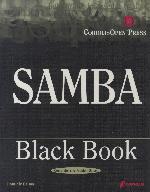

SAMBA Black Book is about providing server message blocks (SMB) networking services in a mixed operating system network.

Author: Dominic Baines
Publisher: CoriolisOpen Press
Price: $49.99 US
ISBN: 1-57610-455-9
Reviewer: Daniel Lazenby
SAMBA Black Book is about providing server message blocks (SMB) networking services in a mixed operating system network. This 13-chapter book offers the reader foundational information, advanced topics and explores administrative issues. The book is designed and written to present the steps involved with building Samba servers. The book's examples focus on running SMB services on top of NetBIOS over a TCP/IP network. The book is well illustrated with screen captures, figures, tables, file listings and sample file segments.
The target audience leans toward NT administrators involved in UNIX integration. Nevertheless, UNIX administrators involved in NT integration will also find a wealth of information on providing SMB networking services to Windows clients.
There is a movement to publish a Common Internet File System (CIFS) file access protocol for Internet use. CIFS is based on the SMB protocol. Several sections of the book discuss using SMB and CIFS server resources lumping them together in several discussions. Visit the http://www.cifs.com/ web site for specific details and the status of CIFS.
SAMBA Black Book opens with a quick tour of networking, obtaining and installing Samba, and provides the steps for setting up Samba file and print servers. Next, Microsoft client use of Samba servers, configuring Win95/98/NT to use a SMB/CIFS server resource, and steps for using SMB/CIFS from a UNIX machine are presented. Following this are steps for using SMB/CIFS in complex network environments and using Samba as a domain controller.
Advanced topics include automating Samba, using it as a FAX server, and performance tuning. Solutions to complex mixed operating system networking challenges are offered as well. Examples of the solutions offered include browsing through multiple subnets, running databases on Samba servers, operations through an IP filtering firewall, user login authentication, Microsoft Windows roaming profile support, and backup and recovery of a mixed operating system network.
Next, steps for securing Samba servers and Samba troubleshooting are provided. Chapter 13 contains a collection of tidbits such as Samba bug fixes, some early words about Windows 2000 and Samba, and the forthcoming Samba Win NT printer support.
Information is well laid out and labeled. Major topic titles are written as statements of knowledge or a task to be performed. “Using NetBIOS”, “Understanding SMB” and “Setting Up a Share” are some example titles. Each chapter opens with the major topic titles repackaged as a list of Immediate Solution statements. “Setting Access Rights on Shares for Different User Groups” is one Immediate Solution statement from Chapter 4. The book presents only the information needed to understand the idea or accomplish the task. I feel this approach keeps the book very focused—the words lean and the content meaningful.
Readers knowledgeable about a subject area can easily skip over chapters or sections of chapters without hindering their implementation of Samba. I found myself reading the first few chapters sequentially, then began skipping around, reading only that which supported the task I was performing or information I was seeking. For example, I wanted to know what programs made up Samba. I found a detailed discussion of the Samba executables. Each Samba executable was first divided into one of three groups: servers, clients or utility. Next, the author presented the purpose of each program. Then he moved on to discuss the characteristics and use of the program's options. This explanation gave me a good feel for the location of Samba functionality.
Appendix A of this book lists sources for Samba and Samba documentation. Internal smb.conf constructs, parameters and legal parameter values are discussed. Appendix B is a delightful touch. It contains a list of additional resources, organized according to chapter and subject area.
Many acronyms are used in this book. The index did not help me when I wanted to find the first use of an acronym and its associated explanation. One example is CIFS. I remember reading about CIFS in several places, yet I could not find the acronym nor the phrase “Common Internet File System” listed in the index.
The accompanying CD-ROM reportedly contains a complete copy of the Samba FTP site and copies of configuration scripts contained in the book. Various programs mentioned in the book are also included on the CD-ROM. Binaries for some Linux distributions, commercial flavors of UNIX and related operating systems.
According to the book, binaries supporting 19 operating systems were included. I selected Novell, MVS, IRIX, AIX and Solaris operating systems from the list. I could not find a binary, or reference to a specific binary, for Novell, MVS or IRIX on the CD-ROM. Granted, this may not be a problem for most people, I mention it only to point out that there are some differences between what the book says is on the CD-ROM and what I could find on it. The latest release (at the time of pressing the CD-ROM) of the RFCs is included.
Technology often travels faster than book publishing. As the author suggests, visit the Samba web site (http://www.samba.org/) to obtain the latest release of Samba and its documentation. From what I read on the Samba 2.07 announcement page, the solutions offered in SAMBA Black Book should still apply.